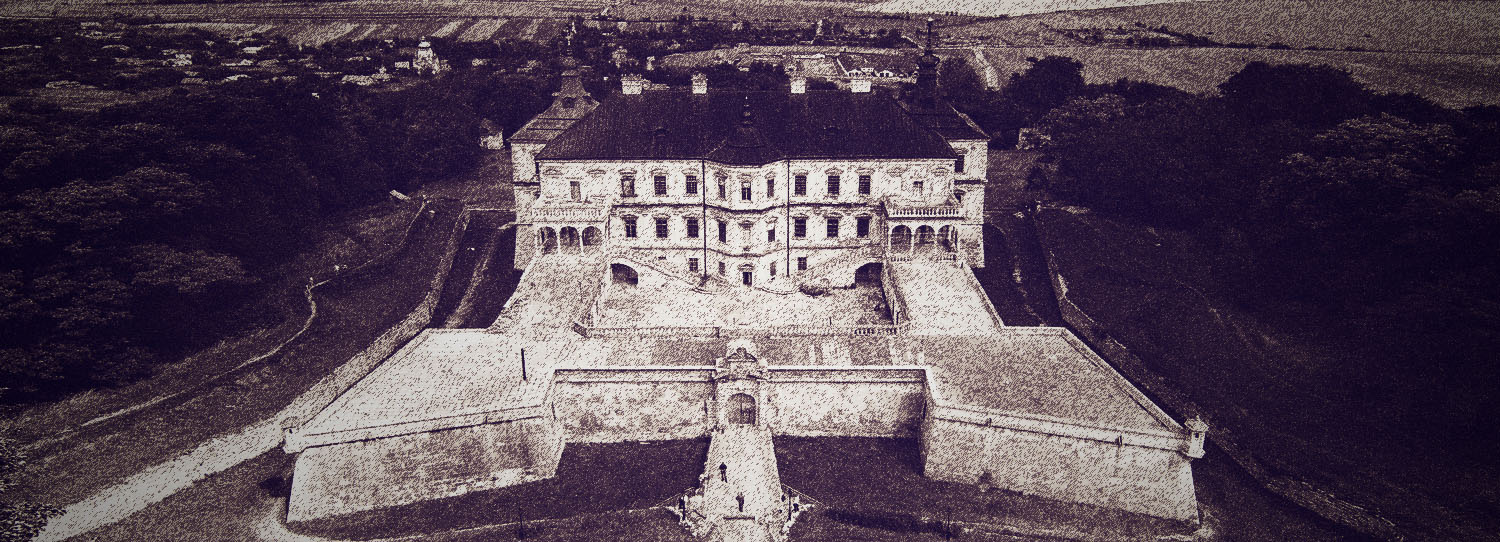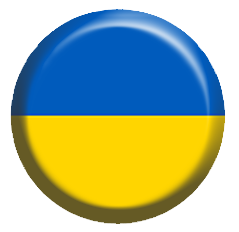Palace and fortress complex in Podhorce
"The castle in Podhorce, although somewhat slim, is undoubtedly the most beautiful building in Poland"
François Paul d'Alerac, "Anecdotes de Pologne"

The team of "palazzo in fortezza" in Podhorce belongs to the most valuable monuments of history and culture of the former Republic. In 2008, it was listed on the World Monuments Watch as one of the 100 monuments of exceptional value in the world, threatened with destruction. Since 1996 it belongs to the Lviv Art Gallery. International rescue of the palace in Podhorce is conducted by the Podhorecki Castle Foundation based in Lviv. In the walls of the palace were shot scenes for the film "Deluge" and the Russian adaptation of "Three Musketeers". Near the object are three other - in Olesk, Złoczow and Brody.
One of the earliest references to the Podhorca is from 1440. The village appears in the document of Wladyslaw Warneńczyk, which confers it on the property of the former tenant, Janusz Podhorecki, the coat of arms of Belina. In 1540, the king Zygmunt I. confirmed the new document. The goods remained in the hands of the Podhoretski family until the 1930s. In 1633, the king's crown was purchased and Stanisław Koniecpolski, the king's castellan, was purchased. In 1643 he founded a silk fabric factory in Podhorce. He also started production of Turkish headdress.
In the years 1635-1640 built a palace-defense complex, acting as a fortified residence, erected "for the enjoyment of tasty rest after military hardships." The style of the building indicates the French architect. It was with great probability that Guillaume le Vasseur de Beauplan - the marquis, military engineer, cartographer and traveler. The Frenchman was responsible not only for the construction and fortification of numerous fortresses and villages in the Volyn, Podolski and Kiev voivodships. He took part in Stanisław Koniecpolski's expedition against the Cossacks, and also published a famous work describing the lands of Ukraine at that time.
Adolf Szyszko Bohusz stated that basements and part of the walls of the ground floor come from earlier, 16th century buildings and were absorbed by the residence. Construction work was headed by Mikolaj Silvestri, and after his death Johann Ludwig von Wohlzogen. The palace rises on the edge of the slope to the north, making it visible from a distance of many kilometers. It is a regular quadrangle with corner bastions. It was erected as a French baroque of the turn of the 16th and 17th centuries, although its layout also has renaissance features. This is particularly evident in the strong accentuation of the transverse axis of the triangular building, and in the shape of the northern facade (triangular central projection and two side pavilions). The palace was originally two-storey, pavilions and riszites were upper floors. Bastions on which the pavilions are supported are surrounded by a stone balustrade with turrets. A stone bridge leads through the artificial moat to the gate. The gate is closed. Its external portal is equipped with two rustic entry columns and two fronts. The coat of arms of Koniecpolskie Pobóg is placed in the upper front and the lower one is accompanied by Szreniawa Lubomirski. At the gate was a plaque with the words "Sudoris Martia victoris, Victoriae Triumphus, Triumphi Quem." Behind it is a small courtyard connected to the residential part - representative open staircase. It is surrounded by walls of the walls where kitchens, chambers and warehouses are located. Stairs at the sides of the main entrance were added in the years 1682-1696. They lead to the two walled walls of logs with features of Italian Mannerism. The flat roofs of both elements support the eight columns ending in arcades. The vast undergrounds served as crew quarters and warehouses, and their thorough research is still ongoing. The residence also includes the Church of Sts. Joseph, originally a chapel of Our Lady of Sorrows, and from 1861 a parish church.
In 1648 and 1651 the castle relied on Cossacks, and the damage was thoroughly repaired for a total of 100 thousand. crowns. In 1682, after the death of Stanisław Koniecpolski, the estate was inherited by his only son - Aleksander. The grandson and the name of the hetman gave Podhorce Jan III Sobieski. The king's court and the French traveler, François Paul d'Alerac, wrote in the Anecdotes de Pologne, "The castle in Podhorce, although somewhat slim, is undoubtedly the most beautiful building in Poland, and even in every other country it would belong to the extraordinary buildings. in good taste it consists of a main residential building, two side pavilions and a small slim tower embedded in the center, decorated with a dome and giving the whole building a very wonderful exterior. it is small and is too slim. (...) It lies on the edge of a high mountain, under the protection of four small, brick brick bastions with a trench and a stone dugout with counters. (...) The small courtyard courtyard is decorated with very impressive galleries. Handrails, lined with marble, combined with long porticoes on the columns. The magnificent stairs, covered with dome. The apartments inside the palace are well laid out and very decorative. In everything, your majesty and splendor. The marble doors lead to the rooms, and the walls shine from gold and paintings. The double row of rooms resembles Italian style and coincides at the end into one huge hall with two doors leading to the balcony. There is a view from there (...) Nothing more pleasant than the view from the castle. At the foot of the mountain there are five or six raised terraces rising upwards, forming as many as several floors of gardens, caves, statues, ponds, pavilions on large masonry columns and window sills. From one garden to another leads beautiful stairs, and beyond the last garden stretches across the entire width of the mountain and extends towards the visitor below a beautiful fruit orchard. On the right and left side of the orchard are two large horseshoe shaped arbors, from which the new stairs lead to the top of the mountain. "
Podhorce was inherited by the princess Konstanty Władysław. So far, the monumental mansion has collapsed, because the new owner has not looked after her personally. It was redeemed in 1718 by the great crown Mateusz Rzewuski, who restored her splendor. His son, Waclaw, enlarged the castle. He built the second floor over all still one-storey parts of the palace. He removed the central tower, replacing it with a hip roof. He founded a library containing about 6,000 books, an archive of Sobieski and Koniecpolski families, a theater, a printing house, an alchemical laboratory, and founded a church located in front of the gate. He also reinterpreted the interior. Damask and burkatel pads replaced canvas, painted flowers, birds, geometric figures, landscapes or architecture. Walls of 1/5 height were lined with imitation marble. For the first half. In the eighteenth century a considerable part of the furnishings of the palace began to be made of equipment imported from France and England, or locally manufactured on them modeled. These were Louis XIV-style chairs, covered with kurdyban leather embossed in colorful and gilded ornaments depicting leaves, flowers and birds, and Dutch-style chairs. Regatta style veneers veneered with violet wood. For the most artistic artwork of local products from this period, a wall table, based on four curved, ornamented rocaille legs. At his table was a bird picturing a pecking grape in a imitation marble frame. Most of the furniture represented the style of Louis XV. There was also a large amount of Chinese and Saxon porcelain and a large collection of Eastern carpets and weapons. The collection of paintings was Polish, most of them portraits and busts, including numerous works by Szymon Czechowicz.
In 1767, Waclaw Rzewuski was ordered to repatriate to Kaluga, where he was imprisoned for five years. At that time Podhorodecki Castle served as a military headquarters of the Russian Empire. Neither of the subsequent owners had completely rebuilt the devastated soldiers then. Podhorce was under Austrian rule. Waclaw Rzewuski did not return to them. After his death, the palace was inherited by Seweryn Rzewuski. He was not interested in the estate, leaving the management completely in charge of the economy. Then the lion's share of the rich castle was auctioned off. Konstant of Lubomirskis, widow of Seweryn, brought out more equipment to Hrehorówka in Volhynia, and to Lviv. In 1826, Podorce inherited Waclaw Rzewuski, known as Emir Taj ul-Fahr, known for his turbulent life. He died in the battle of Daszow during the November Uprising. His plenipotent Feliks Długoborski sold out another part of the collection. The palace fell to such an extent that it lacked roofing and windows in the windows. The only rooms kept in relatively good condition were the rooms inhabited by plenipotent.
Leon Rzewuski, son of "Emir", took a personal custody of the Podhorce in 1833. He covered the palace with a new roof and glazed or closed the windows. He renovated the ceiling beams and the "bench". In the November Uprising he served in the General Staff of the Józef Chłopicki. He won the battle at Olszynka Grochowska, for which he received the Golden Cross Virtutti Militari and the rank of captain. In 1865, ruined by repressive rebellion, he sold the residence to Prince Władysław Sanguszka, who made the interior available for sightseeing. The Prince has thoroughly renovated his residence. Replacement of floor beams on the ground floor, exterior balustrade, masonry wall holes, left wing roof replaced, remains of the castle collection. The work was supervised by the burgher Antoni Kryczynski. The other owners were Fr. Eustachy Sanguszko and Fr. Roman Sanguszko.
At the end of the 19th century, the owners' apartments and guest rooms were on the ground floor. In the hallway there was a canine and mammoth tooth, the portraits of King Augustus III, Maria Józefy, the painting "Inquisition of Saska" and the image of Stańczyk. The dining room was decorated by a Turkish tent from Vienna and pictures of Wenceslas "Emira" Rzewuski, his children and his wife, Rozalia of the Lubomirskis. Turkish tents were arranged in several rooms, including the large living room, bedroom and owner's office and two guest rooms. Most of the furniture was nineteenth-century, Biedermeirowska. The collection of paintings was supplemented by Franco-Saxon paintings and some valuable paintings by Szymon Czechowicz.
"Chamber" from the 18th century was called the Knight's Room or Armory. The door was set up in a marble portal topped with a coat of arms. The hall was heated by two faience furnaces (placed here by Mateusz Rzewuski) and a fireplace. Over the fireplace was a mirror surrounded by a gilded relief with motifs of panoply. The paintings were still painted from Koniecpolskie times. In addition, an unusual size Persian carpet was placed between two Louis XV timepieces. The walls were bent under the richness of the paintings. One of them was a reproduction of Stefan Dolabelli's controversial "Ruthenian homage" depicting Stanisław Żółkiewski presenting the captives of captured Shia Zygmunt III and the prince Władysław. This painting and his copies from Michał I Fiodorowicz were a salt in the eyes of the rulers of the Russian Empire and his later heirs. In addition to the unmistakable ant and defenses, decorating the hall, there were about forty complete gears, including hussars, armored and artillery. In the Knight's Chamber of Rozalia of Lubomirski Rzewuska undertook the Emperor Franz I.
The aesthetic qualities of the chapel drew the attention of French traveler François Paul d'Alerac, staying at the court of Jan III Sobieski. It is located on the main axis of the building and is equipped with lateral projections. It has a horizontal pentagon. In the seventeenth and eighteenth centuries, the shrine vertically surpassed the southern amphitheaters of the first floor, which, together with the dome-shaped domes, had to impress upon the faithful. The silhouette of the chapel, which originally had the character of the lateral pavilions, was sheltered by the main body of the palace around the middle of the 18th century on the initiative of Wenceslas Rzewuski. In the three-sided apse, there was an altar. The original floor was laid in a checkerboard made of black marble and gray boards of common stone. In the 2nd half In the 19th century, it was replaced by sandstone. To the chapel there were three entrances with marble portals crowned with the arms of the Koniecpolskie Strait. Due to the height of the temple in relation to the neighboring rooms, horizontal divisions dominate. Stucco decorations were probably performed by Italy's Giovanni Battista Falconi. The walls decorate the Corinthian pilasters, the first level smooth, the second channeled, supporting the beam. The stucco frieze separating the two floors represented a motif of even travelers' boilers on the background of crossed banners and banners with pennants, a drum on the background of banners and crosses, a mane and a mace, among many other objects are also muskets and jugs. Breaking fields were covered with hussars, against the background of crossed sabers and axes, and shields and knives with crossed hats and clubs. Opposite the altar, above the entrance, there is a choir platform. The colors and theme of the decorations passed from the bottom, the earth's sphere, to the dome, representing the sky. When the mansion was owned by Rzewuski, the left side of the portal was the armor of Michał Florian Rzewuski, who was famous for his left wing during the Battle of Vienna in 1683. In 1830, the chapel vault was collapsed and replaced by a less decorative dummy.
During World War I, the castle was robbed twice. He suffered also during the Polish-Soviet war of 1918-1920 and in 1944. After World War II, the Soviet authorities put in place a tuberculosis hospital. Seriously damaged by fire in 1956. Devastations are still visible, but efforts are being made to restore the glory of the historic team. Work is underway to develop a complete, precise concept for the future use of the complex, and thus to identify the most urgent security and conservation work, often extremely urgent, of a rescue nature (eg for some of the exterior facade plasterings in loggia, decorated with illusionist polychrome or architectural retail). In combination with full measuring and visual architectural documentation and prioritization, the preparation of such a concept in the entire park-building assumption, combined with full measuring and visual architectural documentation and prioritization, will allow a realistic estimation of the cost of redevelopment.
No less important is the implementation of competent conservation and financial supervision for the implementation of the work and the estimation of the costs of such supervision in the budget. At the appointed time and in connection with the extraordinary events that will evolve the ongoing restoration work, convening committees should be convened, with specialists in the field, to make binding decisions regarding the conduct of the ongoing conservation work. It is necessary to coordinate the work of the teams performing the works and for technological reasons to follow their proper order. In this case, it is necessary to avoid the implementation of temporary actions promoting the aesthetics of exterior elevations or interiors conducted by unqualified persons, as this poses a threat of irreversible damage to the structure of the historic object (either mechanical or secondary, chemical or physical resulting from the use of inappropriate materials such as paints).
Preparing the overall concept of using the monument complex should aim at the fullest possible conservation and restoration of historic monuments, not only architecture, architectural detail and equipment, but also the park and urban establishment itself (eg without the introduction of occasional, historically insufficient objects of small architecture and commemorations). It is absolutely necessary to restore the layout of communication arteries and historic plantings in the park, eliminating the post-war layering in this area. Supported actions should be appropriate queries, and in the implementation of referring to a strictly defined historical moment.
Priority should be given to the use and incorporation of original materials (including stone), including those currently stored separately in different locations within the historic complex. It is necessary to prioritize them and identify the original location. Particularly stone pavements or walls of the bastion system should be supplemented with old, original material and should be placed at the original location (prior documentation required) using original techniques and jointing materials (mortar, pavement, etc). ). It is unacceptable to treat to regular secondary shapes, to align the individual stone blocks, or to plaster them with unsuitable material. In the case of historically justified reconstruction, materials and technology corresponding to the original solutions should be used.
The conditions of development and investment in the immediate vicinity adjacent to the castle park should be strictly defined and secured by binding legal acts.
Due to the great historical value of the historic complex of Podhale, its vastness and its cubature, its proper coordination, liquidity and quality of work is necessary to establish a permanent council composed of representatives of the owner, investors and experts in the field of revaluation and its proper competent and legal.
Bibliografia
1) Aftanazy R., Materiały do dziejów rezydencji. Dawne Województwo Ruskie: Ziemia Halicka i Sandomierska, t. VIIa, red. Bajanowski A., Warszawa 1990, s. 424-465;
2) Bania Z., "Pałac w Podhorcach", Roczniki Historii Sztuki, t. XIII (1981), s. 97-170;
3) Czołowski A., "Dawne zamki i twierdze na Rusi Halickiej", Teka Konserwatorska. Rocznik Koła C. C. Konserwatorów Starożytnych Pomników Galicji Wschodniej, t. I (1892), s. 96-100;
4) Kryczyński W., Zamek w Podhorcach, Złoczów 1894;
5) Nikiel M., Przyczynek do działalności hetmanów polskich na Ukrainie w XVII wieku, [b. m.] 2015;
6) Paduch K., "Pałac w Podhorcach w latach 1865-1939. Stan badań i postulaty badawcze.", Saeculum Christianum, t. XXIII (2016), s. 223-231;
7) Ross J., "Kaplica zamkowa w Podhorcach", Biuletyn Historii Sztuki, 1/1974, s. 42-53;
8) http://lviv-art-gallery.virtual.ua/ua/;

View from its northern balconies.

